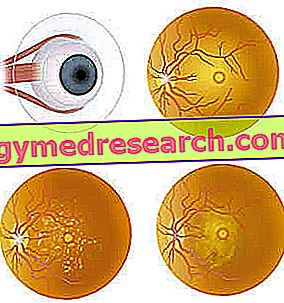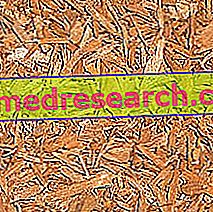Generality
The human body is the physical structure of the human organism, formed by about 37.2 trillion cells and organized in a head, a neck, a trunk, two upper limbs and two lower limbs.

The organs, cooperating among themselves, take part in the formation of the so - called systems or apparatuses .
The human body has a specific chemical composition. The latter mainly includes: water, lipids, proteins, glucides, nucleic acids and inorganic minerals.
Due to aging, the human body undergoes numerous changes, some of which are also very profound.
What is the human body?
The human body is the physical structure of the human organism, resulting from the synergy of a huge number of different cells; this structure is organized in a head, a neck, a trunk, two upper limbs (each including an arm, a forearm and a hand) and two lower limbs (each comprising a thigh, a leg and a foot).
Cells represent the fundamental units of life . In fact, they constitute the tissues → tissues of different types make up the organs → sets of different organs form the systems (or apparatuses).
Structure
From birth to reaching adulthood, the human body undergoes some physical changes, which however do not alter its general organization (which includes a head, a neck, a trunk, etc.).
These changes mainly concern body height, body weight and the distribution of muscles and fat, and depend on various factors, including diet (understood as a diet), physical exercise, sex and genetics.
THE CAVITIES OF THE HUMAN BODY
Looking at it from the inside, the human body has several cavities .
The two most important cavities, by size, are the abdominal-pelvic cavity (the largest) and the thoracic cavity .
The abdominal-pelvic cavity takes place in the lower part of the trunk and contains numerous vital organs, including the liver, kidneys and intestine.
The thoracic cavity occupies the upper part of the thorax and houses, inside, the heart, the lungs and a tract of the aorta, all fundamental organs for life.
Minor cavities, which deserve a special mention, are the paranasal sinuses . Formed by some bones of the skull, the paranasal sinuses are spaces through which air passes and which serve to improve the perception of odors and to amplify sounds and voice.
WHAT IS THE AVERAGE STATUS OF THE HUMAN BODY?
The average height of the human body of an adult man is about 1.7-1.8 meters .
The average height of the human body of an adult woman, on the other hand, is around 1.6-1.7 meters .
In Italy, according to some studies, the average height of the male population is about 1.74 meters, while that of the female population is about 1.62 meters.
HOW MANY BONES DOES THE HUMAN BODY INCLUDE?
The human skeleton, with its bones, is the scaffolding that guarantees stability and support to the human body.
Without the skeleton, the human being would not be able to remain in an upright position and would lack a protective element of the fundamental internal organs.
In the human body, the bones that make up the skeleton are as many as 206 .
Chemical composition
The chemical composition of the human body includes: water, elements of organic nature and inorganic minerals.
WATER
Water is the most conspicuous chemical component. In fact, in the human body of a young adult, the water content represents about 60-65% of the total weight.
Water is distributed both in the so-called extracellular fluids (blood plasma, lymph and interstitial fluids), and inside the cells (here, it constitutes the so-called intracellular fluid).
Water is a solvent and, as such, acts as a transport vehicle for the substances that keep individual cells alive. In addition, it contributes to the digestive process, ensures thermoregulation (think of sweating) and promotes the elimination of waste accumulated in the body.
Does the amount of water contained in the human body vary throughout life?
During life, the amount of water present in the human body undergoes obvious variations.
In fact, from the comparison between a newborn and a very elderly subject it emerges that their quantity of water is decidedly different: in the case of the newborn, it is equal to about 75% of body weight; in the case of the very elderly subject, on the other hand, it is about 50% of the body weight.
Therefore, during the aging process of the human body, the water component is progressively reduced (NB: for the other effects of aging, see the dedicated chapter).
ELEMENTS OF ORGANIC NATURE
The organic elements present in the human body are proteins, lipids, carbohydrates (or carbohydrates) and nucleic acids.
- Proteins : they represent the second most important component of the human body, with a contribution to body weight of around 16%.
There are various types of proteins: proteins with enzymatic function (or enzymes), proteins with transport function, proteins with contractile function, proteins with structural function, proteins with a defense function (for example immunoglobulins or antibodies) and proteins with regulatory function.
- Lipids : existing mainly in the form of triglycerides, cholesterol and phospholipids, they constitute the third most considerable component of the human body, with a contribution to body weight equal to about 13%.
Triglycerides represent an important energy reserve, as they are able to release a large amount of calories.
Cholesterol and phospholipids are two fundamental structural elements of cell membranes. The good health of cell membranes is essential for cell survival and proper functioning.
- Glucides or carbohydrates : they represent a very small component in the human body, as they contribute to a total body weight of only 1%.
However, they are still very important, since they are a convenient source of energy for the various organs and tissues that make up the human body.
Among the various glucides present in the human body, glycogen deserves special mention. Accumulated in the liver and in the muscles, glycogen is a sort of energy reserve, which the human being uses the case of necessity.
- Nucleic acids : they contribute minimally to the total body weight, but they are fundamental for life. Perhaps the best known nucleic acid is DNA, or genetic material. To properly perform its functions, DNA uses another nucleic acid: RNA.
INORGANIC MINERALS
The inorganic minerals present in the human body represent about 5% of the total body weight.
The main ones are: calcium, phosphorus, sodium, potassium, magnesium and iron.
Their functions are numerous. For example, calcium and phosphorus, combined together, participate in the formation of the bone skeleton; calcium as an ion is a fundamental element for muscle contraction; among the various roles covered, sodium and potassium preside over the transmission of nerve signals; iron takes part in the formation of hemoglobin etc.
- Cobalt
- Copper
- Iodine
- Manganese
- Zinc
Organization
In the human body there are about 37.2 trillion cells, belonging to about 200 different types .
Despite this huge number of cell types, human cells can be grouped into just 4 classes :
- the cells that make up epithelial-type tissues (or epithelial tissues);
- the cells forming the muscular tissues (or muscle tissues);
- the cells making up the nervous-type tissues (or nervous tissues);
- the cells that form connective tissue (or connective tissue).
An organ is derived from the union of at least two different fabrics. In the human body, there are also organs formed of all four tissues, such as the heart.
The organs always work in collaboration with other organs, giving rise, in this way, to the systems (or apparatuses ).
A system, to be defined as such, must include at least two organs.
Curiosity. Blood enters the connective tissue.
In the human body, the amount of circulating blood is just over 5 liters.
SYSTEMS OF THE HUMAN BODY
The human body comprises 9 major systems:
- The integumentary system (or integumentary system ). It consists of the skin and all those structures associated with the skin, such as glands, hair, nails, etc. The skin constitutes a defensive barrier against threats from the external environment (such as microbes) and represents a sort of sensitive interface, which allows us to recognize the changes in the surrounding world (for example, perceives temperature changes, the presence of of wind etc).
- The musculoskeletal system . It consists of the skeleton (whose function has already been discussed) and the muscles. Muscles provide the human capacity for movement.
It also includes cartilages, tendons and ligaments.
It can be thought of as the fruit of the union between the skeletal system and the muscular system.
- The respiratory system (or respiratory system ). It is the set of all those organs that allow breathing; it is formed by structures that allow inhalation of air to the lungs.
- The circulatory system (or cardiovascular system ). Includes the heart and vessels within which blood flows (blood vessels). The heart functions like a pump and allows the circulation of blood inside the lungs (NB: the place where the blood is charged with oxygen) and then in the various organs and tissues of the human body.
- The digestive system (or digestive system ). Mainly consists of mouth, esophagus, stomach and intestine (including anus). It is used to absorb nutrients, introduced with the diet, and to eliminate waste products (faeces).
- The excretory system (or excretory apparatus ). It includes the kidneys, the ureters, the bladder, the urethra and serves to eliminate urine, which is a waste product.
- The nervous system . It includes the brain, spinal cord and all the nerves that run through the human body. It is used to transmit sensory information and motor stimuli.
- The reproductive system (or reproducing apparatus ). It consists of sexual organs and is used for reproduction. As is known, men and women possess a widely different reproductive system.
- The endocrine system . It includes all the different glands that secrete hormones, therefore: the pituitary gland, the thyroid gland, the adrenal glands, the pancreas, the parathyroids and the gonads.
Hormones are signaling molecules that perform cellular reactions and guarantee the correct development and functioning of the human body.
Effects of aging
Aging has different effects on the human body.
The skin is the main indicator of the passing of the years: over time, in fact, it becomes increasingly thin and dry, it loses elasticity and tends to become covered with small spots (known as "liver spots" or "spot age").
The hair grows thinner and thinner.
The ability to heal wounds tends to gradually decrease: according to some studies, in a sixty year old it would be 5 times lower, compared to a child of 10 years.
The nervous system suffers losses in terms of number of nerve fibers: for example, the nerves of the auditory apparatus die progressively and this explains why elderly people perceive sounds less.
Important organs such as the liver and kidneys reduce their mass and become less efficient.
The brain becomes smaller, while maintaining its mental and intellectual capacities intact (NB: these are diseases such as Alzheimer's that affect the latter).
Bones tend to lighten and lose calcium. The loss of calcium makes the skeleton more fragile and prone to fractures.
Cartilages become increasingly thinner, favoring the appearance of arthritis.
Muscles slowly lose strength and elasticity, which explains why doctors advise elderly people to exercise (obviously in relation to the age and health of the subject).
The spine undergoes a generalized compression, which leads to a reduction in stature.
The blood vessels, particularly the arteries, undergo a hardening process, lose elasticity and are more likely to be injured, in some cases even very dangerous.
The list of the effects of aging on the human body could continue, but, for reasons of space, we consider it appropriate to stop here.



